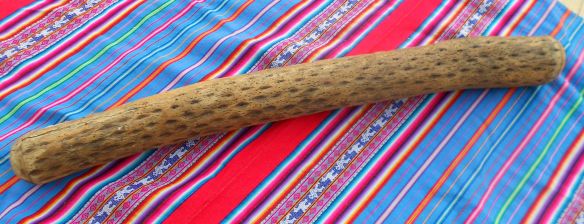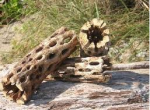 Have you ever heard a rainstick? It’s a long, mainly hollow tube that makes a quiet sound when tilted from side to side, very much like running water or gentle rain.
Have you ever heard a rainstick? It’s a long, mainly hollow tube that makes a quiet sound when tilted from side to side, very much like running water or gentle rain.
What Makes The Rainstick Sound?
 Originally rainsticks were made of natural materials such as the dried lengths of the chola cactus. These long “arms” of dried cacti have small spikes inside so when they are filled with pebbles, seeds or small objects, the contents can’t easily swish back and forth. Instead, the seeds, pebbles or beads gently fall between the spikes creating the unique sound associated with the rainstick. You often see these instruments in South America in countries such as Chile or in the American Southwest, where these cacti are plentiful.
Originally rainsticks were made of natural materials such as the dried lengths of the chola cactus. These long “arms” of dried cacti have small spikes inside so when they are filled with pebbles, seeds or small objects, the contents can’t easily swish back and forth. Instead, the seeds, pebbles or beads gently fall between the spikes creating the unique sound associated with the rainstick. You often see these instruments in South America in countries such as Chile or in the American Southwest, where these cacti are plentiful.
 Make A Mailing Tube Rainstick
Make A Mailing Tube Rainstick
Since most people don’t have dried cacti in their recycling bin, here’s a way you can reuse an old mailing tube or poster container and still make a great-sounding instrument. If you can’t find one of these at home, ask around. Chances are good your recycling needs can be met by a neighbor or family friend and you can save one more object from getting into the waste stream!
Creating The Rainstick Effect
To turn a mailing tube into a rainstick, you need to find a way to create an obstruction – something that will block the materials inside from falling at one time. In bamboo or gourd rainsticks, a series of wooden spikes are used. Instead of that approach, we’ll create a wire “maze” using a combination of floral wire/jewelry wire (or any lightweight wire) and pipecleaners.

Twisted wire ready to be placed inside the mailing tube
Cut a length of wire about two to three times the length of the tube. If you cover the ends with a bit of tape, it’s easy for a child to help scrunch the wire up giving it many twists and turns in a way that will still fit inside the diameter of the tube. Then, twist in some pipecleaners cut in half, throughout the length of your tangled wire. All these things will help catch the contents as they go from side to side to create the pleasing “falling water” effect.
Tune Your Rainstick
The sound of your rainstick will vary greatly depending on what you decide to put into it as well as how much of that item you choose to add. For a quieter rainstick, use smaller objects such as seed beads, birdseed or tiny pasta such as pastina or acini de pepe. Slightly louder are objects like rice, dried lentils, small buttons or paper clips. Even louder are larger dried beans, pebbles, marbles or any large macaroni.
 Here’s a good way of “tuning” your rainstick. Have several bowls of contents nearby. Close one end of your rainstick and add the contents. Seal the other end and try the sound. Dump it back into your bowl and try another. What sound is most pleasing to you? Or mix and match contents. It’s a fun way of experimenting with sound to discover what sounds best to your ear.
Here’s a good way of “tuning” your rainstick. Have several bowls of contents nearby. Close one end of your rainstick and add the contents. Seal the other end and try the sound. Dump it back into your bowl and try another. What sound is most pleasing to you? Or mix and match contents. It’s a fun way of experimenting with sound to discover what sounds best to your ear.
Once you’ve decided on the perfect sound for your rainstick, there are lots of creative ways to decorate the outside of the instrument. You can color with crayons or permanent markers, create stripes from colorful tape, or even decoupage photos or magazine pictures onto the tube. You can paint a coat of glue on the rainstick and slowly wind different colors of yard around it. You can also cut squares or small pieces of fabric, cover them with a layer of glue and create a quilt or collage effect for a beautiful handmade rainstick. Feel free to get creative and make something that is truly unique!
Play Your Rainstick
Rainsticks are most often played by simply turning them upside down. However, you can also hold them horizontally and shake the contents back and forth like a rattle or shake the stick as the contents fall producing some nice variations in ways to play this simple but versatile instrument!
